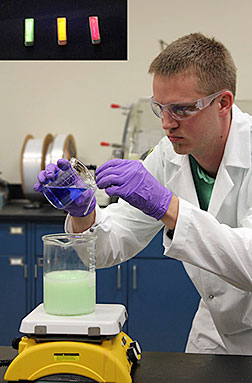- Number 453 |
- November 30, 2015
ORNL Wigner Fellow writes the recipe for glowing research

ORNL's Michael Chance
In 2013, an inorganic chemistry student at the University of South Carolina conducted neutron experiments at DOE's Oak Ridge National Laboratory for his Ph.D. work.
Two years later, Michael Chance is picking right back up on his research at ORNL as a Eugene P. Wigner Fellow, the most prestigious fellowship at ORNL.
The Wigner Fellowship, established in 1975, was created in honor of Nobel Laureate and the first ORNL Director of Research and Development.
ORNL Wigner Fellows are exceptional early career scientists like Chance who, for his doctoral thesis, established a new crystal growth technique. As a Wigner Fellow, Chance has a rare opportunity to pursue research programs, collaborate with ORNL distinguished scientists and staff and access national laboratory expertise, facilities, and programs.
“It’s exciting, being a Wigner Fellow and getting this support from a national lab to do real science and solve real problems,” said Chance.
As a Wigner Fellow, Chance has had the opportunity to work with the Critical Materials Institute (CMI), an Energy Department Innovation Hub led by Ames Laboratory. CMI, supported by the Advanced Manufacturing Office in DOE’s Office of Energy Efficiency and Renewable Energy, is dedicated to reducing the nation’s dependence on vital, yet expensive and critical materials.
Chance’s CMI research requires him to pull from his training as a solid-state chemist to reimagine and improve an important, everyday technology: fluorescent lighting.
Flick on a fluorescent light switch, and chemistry happens. Within the glass light tube is mercury vapor that bombards a luminescent coating, called phosphor, with UV rays. This causes the phosphors to emit visible light.
“The problem with the fluorescent lights that are commonly used is that they require phosphors with a large amount of rare earths in them,” said Chance.
Fluorescent lights are more energy-efficient than incandescent light bulbs, but LED lighting has recently emerged as a forerunner in efficient lighting technology. Transitioning to the next-generation technology won’t happen rapidly, Chance explained.
“LEDs (light emitting diodes) are rapidly growing their market share, but fluorescent lighting is poised to remain relevant for some time,” said Chance.
Chance is part of an ORNL Materials Science and Technology Division team whose goal is to lessen the dependence on rare earths in the popular fluorescent lighting source.
“Currently, we’re depending on these materials that are very expensive and at risk for supply disruptions,” Chance said. “DOE targets require us to significantly reduce the amount of rare earths in the phosphor coating to address this.”
To do so, the team is testing new combinations of chemicals, tweaking the recipe for creating phosphors to find direct substitutes for the current phosphor blend.
“A lot of solid-state science is like cooking—you’ve got to find the right recipe,” he said. “It’s not just what goes in the recipe, it’s the way you cook it that really makes a difference. Once I make a phosphor, it’s got to stand up to a really tough testing environment. It’s not easy,” said Chance.
He points to his background in crystal growth methods as a big part of helping in the Edisonian approach for finding the right combination of chemicals.
“You need to use chemistry knowledge and intuition for the phosphor research. You need to discover trends from what’s in the literature, new and old, to see what to try next,” Chance said.
He keeps a lab notebook prominently on his desk, full of what he calls “scrupulous notes” on his successes and setbacks in synthesizing manganese-based phosphors.
It is paramount to keep track of everything in the process so others can reproduce it.”
The transition to the thriving science culture at the national laboratory from university studies has been relatively easy for Michael Chance. Though he’s a native of Marshall County, Kentucky, Chance recently settled in East Tennessee with his wife, an art teacher at a local elementary school.
He’s adjusted to life at ORNL with ease.
“While I was a student at the University of South Carolina, our research group collaborated on a project at ORNL with Lynn Boatner [leader of the Synthesis and Properties of Novel Materials Group in ORNL’s Materials Science and Technology Division],” said Chance.
“Starting at the lab, this time as a Wigner Fellow, and being able to pick up where I left off—it’s been a good fit.” – By Ashanti B. WashingtonSubmitted by DOE's Oak Ridge National Laboratory
